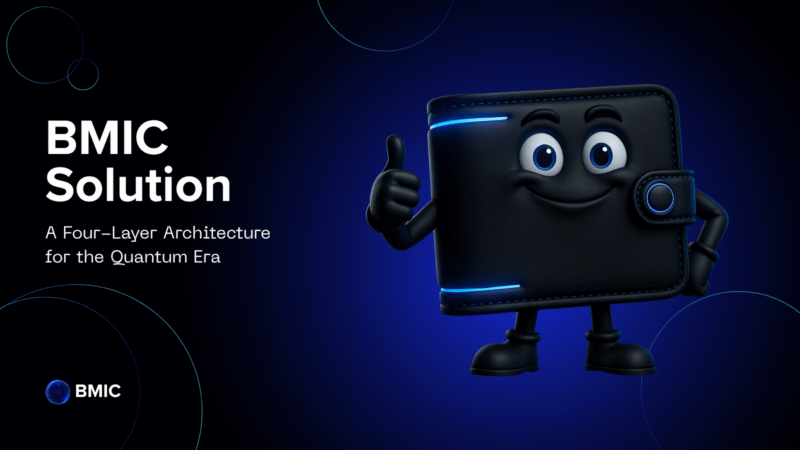The BMIC Solution

A Four-Layer Architecture for the Quantum Era
BMIC is developing a holistic solution to the challenges of quantum security, centralized control of compute, and AI’s insatiable demand for processing power. At its core is a quantum-resistant wallet, supported by enterprise-ready security services, decentralized compute access, blockchain governance, and AI-driven orchestration.
This four-layer architecture ensures that BMIC is not just a single product, but an evolving ecosystem capable of protecting today’s digital assets while enabling tomorrow’s breakthroughs.
Layer 1: Quantum Security Layer (Wallet + QSaaS)
Security is the foundation of BMIC. The first layer is dedicated to ensuring that assets, transactions, and digital identities are safe against quantum threats.
- Quantum-Resistant Wallet. Built with post-quantum cryptography (PQC), the wallet ensures that keys and transactions remain secure even as quantum machines advance.
- QSaaS APIs for Enterprises. Financial institutions, fintechs, healthcare providers, and governments can integrate custody, key management, and secure communications into their platforms without needing to build in-house quantum security systems.
- Future-Proof by Design. Legacy systems will face costly migrations to PQC standards. BMIC avoids this risk by being quantum-native from day one, minimizing disruption as standards evolve.
- Optional QKD Integration. For high-security industries, Quantum Key Distribution can be layered in to guarantee unbreakable key exchange.
- Compliance-Ready. Designed with strict industries in mind, including finance and healthcare, where regulation and data privacy are non-negotiable.
Layer 2: Quantum Hardware Layer (Meta-Cloud)
Quantum computing is currently siloed in the hands of a few providers. BMIC solves this by building a Quantum Meta-Cloud — a unified access layer that connects multiple hardware providers into a single decentralized network.
- Global Connectivity. Interfaces with leading providers like IBM Quantum, Amazon Braket, Azure Quantum, IonQ, and Quantinuum, ensuring diversity of access.
- Vendor-Agnostic Access. Removes dependency on a single corporate provider, reducing the risks of vendor lock-in and censorship.
- No In-House Burden. Enterprises and developers gain access to quantum compute without needing to build their own cryogenic labs, vacuum chambers, or specialized infrastructure.
- Scalable Compute Liquidity. By pooling resources from multiple providers, BMIC can deliver elastic compute capacity that grows with demand.
- Community-Governed Access. Instead of corporate gatekeepers, compute is distributed and transparent, with incentives for hardware contributors.
Layer 3: Blockchain Access Layer (Token Economy + Governance)
The blockchain provides the trust, transparency, and incentives needed to keep BMIC fair, secure, and self-sustaining.
- Payments & Access. The BMIC token serves as the key to unlocking wallet features, QSaaS APIs, and compute resources.
- Staking for Security. Institutions and service nodes stake tokens to secure the network, reinforcing reliability while earning rewards.
- Burn-to-Compute Model. Tokens are converted into BMIC Compute Credits (BCC), the fuel for running quantum workloads.
- Transparent Operations. Compute requests, wallet interactions, and governance decisions are recorded immutably on-chain.
- Governance. Over time, token holders will guide key decisions.
Layer 4: AI Orchestration Layer (Optimization + Resilience)
Artificial intelligence is woven into BMIC to make the system smarter, faster, and more adaptive.
- Performance Optimization. AI minimizes the latency often associated with PQC, ensuring smooth user experiences for wallet transactions and enterprise-scale operations.
- Threat Detection. AI continuously analyzes patterns across cryptographic and compute traffic, flagging anomalies and predicting vulnerabilities before they can be exploited.
- Adaptive Cryptography. As NIST and global bodies approve new PQC algorithms, AI ensures BMIC can dynamically update without manual intervention.
- Intelligent Workload Balancing. AI routes jobs across classical and quantum systems, ensuring resources are used efficiently.
- Fault Tolerance. If a compute node or QPU fails, AI automatically redistributes tasks, maintaining uptime and system resilience.